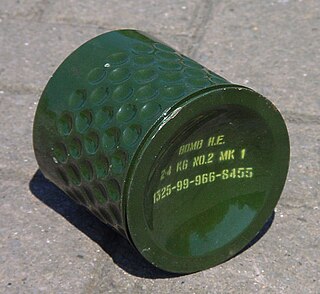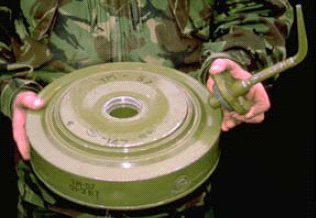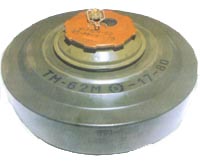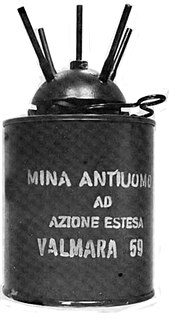
The M198 howitzer is a medium-sized, towed 155mm artillery piece, developed for service with the United States Army and Marine Corps. It was commissioned to be a replacement for the WWII-era M114 155 mm howitzer. It was designed and prototyped at the Rock Island Arsenal in 1969 with firing tests beginning in 1970 and went into full production there in 1978. It entered service in 1979 and since then 1,600 units have been produced and put into operation.
The GATOR mine system is a United States military system of air-dropped anti-tank and anti-personnel mines developed in the 1980s to be compatible with existing cluster dispensers. It is used with two dispenser systems—the Navy 230 kg (500 lb) CBU-78/B and the Air Force 450 kg (1,000 lb) CBU-89/B. Additionally the mines are used with the land- and helicopter-based Volcano mine system.

The MON-50 is a claymore shaped, plastic bodied, directional type of anti-personnel mine designed and manufactured in the Soviet Union. It is designed to wound or kill by explosive fragmentation. The mine is similar to the American M18 Claymore with a few differences.
The MON-90 is a claymore shaped, plastic bodied, directional type of anti-personnel mine designed and manufactured in the Soviet Union. It is designed to wound or kill by fragmentation. The mine is similar in appearance to the MON-50, but is approximately twice the size with a much greater depth.

The HB 876 mine was an air dropped area denial weapon. It was used as part of the JP233 runway denial system and the 'Hades' variant of the BL755 cluster bomb. As a result of the anti-personnel mine ban it was withdrawn from British Royal Air Force service, and the last stockpiles of the mine were destroyed on 19 October 1999.
The TM-83 is a Soviet off-route anti-tank mine, first shown publicly in 1993. The mine consists of a large Misznay Schardin effect warhead and infra-red and seismic sensors.

The TM-57 mine is a large, circular Soviet metal-cased blast anti-tank mine. It can either be triggered by a pressure or a tilt-rod fuze. A development of the TM-46 mine, it is found in Africa, the Middle East, and South East Asia.

The PMN series of blast anti-personnel mines were designed and manufactured in the Soviet Union. They are one of the most widely used and commonly found devices during demining operations.

The AT2 mine is a scatterable anti-tank mine developed by Dynamit Nobel. It can be scattered from artillery rockets or from mine laying systems, and was used by the British, German and Norwegian armed forces until the signing of the Ottawa Treaty.

TM-62 is the designation for a series of Soviet anti-tank blast mines. The mines have a central fuze and typically have a 7.5 kg explosive charge, however they vary greatly in detail. The mines can be laid manually or automatically from a mine laying machine including the PMR-1, PMR-2 wheeled towed mine layers, the GMZ tracked mine laying vehicle and the VMR-2 helicopter mine laying system.
The SB-81 is an Italian plastic cased minimum metal anti-tank blast mine dating from the early 1980s. The mine uses an air pressure based fuze, which gives it protection against overpressure and blast. It can therefore be regarded as a blast resistant mine. The mine can be scattered by hand or by mine laying systems.

The Valmara 59 is a large cylindrical Italian bounding anti-personnel mine. It is the first in the "Valmara" family of mines produced by Valsella Meccanotecnica, and was followed by the Valmara 69 and VS-JAP. The mine's body is metal with a distinctive five-pronged head. The central prong has a hole, to allow the threading a trip wire. The inner body of the mine has a main charge surrounded with approximately 1,000 steel cubes, below which is a steel wire connecting it to the base of the mine. When the mine is triggered a small charge launches the mine into the air approximately 45 cm before the steel wire is pulled taut, the jolt of which pulls a striker into the detonator. A secondary time fuse triggers the mine after three seconds if it has not detonated after being triggered.

The VS-JAP is an Italian bounding anti-personnel mine. It is the latest of the Valmara family of bounding mines that includes the Valmara 59 and Valmara 69. The mine has a waterproof plastic faceted cylindrical body with a three-pronged cap, with a central fixing point for a tripwire. The fuze is triggered via downward or sideways pressure.
The SAPM is a Chinese scatterable anti-personnel fragmentation mine. It is typically deployed from either 122 mm rockets or truck based mine layers. Once the mine hits the ground, two tripwires are deployed to a maximum distance of 10 meters from the mine. Tension on these wires triggers the mine.

The FFV 028 is a series of steel cased Swedish anti-tank mines that use electronic fuzes. The mines are circular, with a large Misznay Schardin effect warhead in the center of the mine, with the fuzing and sensor electronics located in the dead space above the main charge. The design of the mine dates from the 1970s and uses a magnetic influence sensor to detonate the mine, making it able to attack the full width of armoured vehicles.
The MIACAH F1 is a French off-route anti-tank landmine. It uses a large Misznay Schardin effect warhead to project a powerful self forging fragment capable of penetrating 70 millimetres of armour at a range of 40 metres.
The Model 123 is a small Thai Claymore style directional anti-personnel mine. The mine has a square plastic main body with a convex front face marked with a triangle which is supported by two sets of scissor legs. Inside the main body is a layer of four hundred 5.5 millimeter steel ball bearings embedded in an RDX type explosive. The mine is normally used with an electrical detonator which is inserted into the top of the mine.

The MN-111 is a Polish air-dropped anti-tank landmine. The mine is designed for use on soft ground. The mine is cylindrical with six spring-loaded fins attached to one end of the mine, with the cylinder drawn to a point at the opposite end which is topped with a small wind vane. The mine is stored with the fins wrapped round the outside of the mine. Once the mine is dropped from the aircraft the fins spring outward, acting as a drag parachute, slowing the rate of descent to a peak speed of about 60 meters per second. As the mine drops the wind vane spins, generating the power used to arm the mine.
The MN-123 is a Polish scatterable anti-tank mine. The mine is a flat cylinder, with a bevelled edge. It is normally deployed from a ground vehicle, using a dispensing system holding 80 mines. The mine can also be manually laid. Like the MN-121 mine, it uses a magnetic influence fuze which detects when a vehicle passes over it. It also has an anti-handling device. Both faces of the mine have a Misznay Schardin effect shaped charge, which is reportedly able to penetrate 60 millimeters of armour at an offset of 0.3 meters.

The MW-1 is a German munitions dispenser similar to the British JP233. It is designed to be carried on the Tornado IDS, although it can be carried on the F-104 Starfighter and the F-4 Phantom. The MW-1 started to be phased out after the German Government ratified the Convention on Cluster Munitions in 2009.















